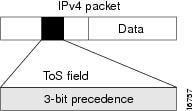What are Locally Originated Packets?
Locally Originated Packets (LOPs) are packets generated and transmitted by the router itself. These differ from transit packets
that pass through the router. LOPs include routing protocols, management protocols, and other locally initiated control messages.
Default QoS markings for protocols
The router assigns default precedence or Differentiated Services Code Point (DSCP) values to various locally originated protocols
|
Protocol or application
|
Precedence and DSCP value
|
L2 PCP value
|
|
BGP, OSPF, CCM (CSM), BFD, RSVP
|
|
|
|
Telnet, SSH
|
|
Not applicable
|
|
SNMP
|
Precedence: 0
|
6 (with or without MPLS encap)
|
|
SSH, SFTP
|
Not applicable
|
7 (with or without MPLS encap)
|
Some protocols such as BGP, RSVP, CFM, and LDP and the management protocols allow setting explicit precedence or DSCP values.
Traffic class assignment by Cisco IOS XR release
|
Cisco IOS XR release
|
Traffic class value
|
|
Before Release 7.6.1
|
-
Locally generated control plane packets, such as IS-IS and BGP, are generated using traffic-class 6.
-
Locally generated BFD over Bundle (IETF) packets, which are generated on the Network Processing Unit (NPU), are generated
using traffic-class 6.
|
|
From Release 7.6.1 onwards
|
-
Locally generated control plane packets, such as IS-IS and BGP, are generated using traffic-class 7.
-
Locally generated BFD over Bundle (IETF) packets, which are generated on the Network Processing Unit (NPU), are generated
using traffic-class 7.
|

Note
|
Bidirectional Forwarding Detection (BFD) uses a DSCP value of 63 (IP-ToS 255) for single-hop sessions and IP-ToS 0 for multi-hop
sessions on the NCS540 router. Due to an SDK limitation, a DSCP value of 48 is not supported.
|

Note
|
Bidirectional Forwarding Detection (BFD) uses a DSCP value of 63 (IP-ToS 255) for single-hop sessions and IP-ToS 0 for multi-hop
sessions on the NCS560 router. Due to an SDK limitation, a DSCP value of 48 is not supported.
|
Managing datapath and locally originated packets
On the router, datapath packets and injected packets aren’t differentiated if both their traffic classes share the same Virtual
Output Queues (VOQs). Therefore, in the case of a congested VOQ, the LOCP packets are dropped. To avoid the LOCP packets drop,
Cisco recommends that you have a different traffic class for data path traffic. Alternatively, you can also specify a higher
bandwidth for traffic-class 7 (if ingress traffic rate is predictable).
Optimizing traffic handling by early classification and marking
Classifying traffic helps the router to recognize traffic as a certain type and mark that traffic. By marking traffic early
on its travel, you can prevent excessive reclassification later. You can mark traffic at the protocol level as shown in the
following examples:
Ethernet
The following configuration shows that the outbound Control Hub packets are marked with a precedence value of 2 and EXP of
2, instead of a precedence and EXP value of 6. The SSH packets have a precedence value of 3 instead of 2.
ethernet cfm
mep domain FOO service FOOBAR mep-id 1
cos 2
ssh server dscp 24
BGP
neighbor x.x.x.x dscp
MPLS LDP
mpls ldp signalling dscp
Telnet
telnet ipv4 dscp
SNMP
snmp-server ipv4 precedence/dscp
Syslog
logging ipv4 precedence/dscp
netflow
flow exporter-map TEST dscp
NTP
ntp ipv4 precedence/dscp
ssh client dscp 56
ssh server dscp 56

Note
|
By default, the router marks the Precision Time Protocol (PTP) traffic as high priority. Therefore, the need to prioritize
PTP traffic in the QoS configuration is not required.
|
LOCPs and QoS policies
LOCPs are packets generated by the router itself, such as IS-IS, ARP, and other non-IP-based control packets. These packets
are critical for network operations and are treated with high priority to ensure they are not dropped under normal circumstances.

Note
|
By default, all LOCPs are assigned to traffic-class 7. Considering that LOCPs and LOMPs are generated by the RP, an Ingress
QoS policy cannot be applied. Therefore, you must ensure that the egress QoS policy includes a class-map which matches traffic-class
7. By definition, the egress QoS policy matches all implicitly marked packets.
|
Key features of LOCPs
Discard priority
-
LOCPs originating from the RP or LC CPU have a discard priority set in the appended Buffer Header (BHDR).
-
This ensures LOCPs are not dropped internally under normal conditions.
-
LOMPs do not have this discard priority and are treated as normal traffic.
Queue management
-
LOCPs with discard priority are placed in an implicitly allocated high-priority queue for each physical egress interface.
-
During congestion, LOCPs are not subject to Weighted Random Early Detection (WRED) or Tail-drop queue-limit operations.
-
The tail-drop queue-limit must be hit before LOCP packets are dropped.
QoS policy configuration
-
QoS policies can be attached to physical interfaces or sub-interfaces.
-
If attached to sub-interfaces, the operator cannot attach a QoS policy to the physical interface.
-
LOCPs are always sent out on the default high-priority queue of the physical interface.
Bandwidth reservation
-
A minimum bandwidth of MIN (1% of interface bandwidth, 10 Mbps) is reserved for the default high-priority queue on physical
interfaces without a QoS policy.
-
If a QoS policy is applied, the minimum bandwidth for the high-priority queue is controlled by the configured policy.
Classification and re-marking
-
LOCPs are not subject to traffic policing or re-marking.
-
Non-IP LOCPs, such as IS-IS and ARP, are always sent to the high-priority queue, irrespective of the QoS policy.
Session termination prevention
-
During over-subscription, LOCP drops may occur, leading to session termination.
-
Proper bandwidth allocation and QoS configuration are essential to prevent such scenarios.


 Feedback
Feedback